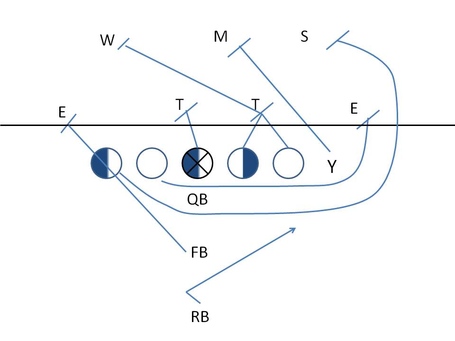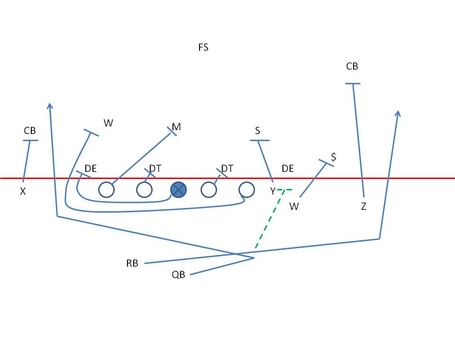Inside the Playbook: OSU's Inverted Veer Package
Ohio State does some interesting things within their offense that make it difficult for defenses to key them correctly. For one, they effectively mix up zone blocking and man blocking schemes, especially power blocking as of lately. In this post we are going to look at 4+ different plays which all utilize and inverted veer look, and explain why it is so difficult to stop them on offense.
Counter Inverted Veer
As I described the inverted veer as power blocking from an option look, let's first look at how "counter trey" is blocked. "Trey" is a bit of a misnomer, as there often isn't a trey block, but it is the most common type of double team that comes from this blocking scheme and thus it is called trey.
To note:
Trey is a combo block from the playside PSE (playside TE) and the PST (playside OT) to the MIKE or backside LB. Deuce is a combo block from the PST and the PSG (playside OG) to the MIKE or backside LB. Ace is a combo block from the PSG and the C to the MIKE or backside LB. For many teams, the FB will typically lead the defense to the ball. The same is said for a typical counter play, where the FB will counter step and lead the defense to the ball. But on a typical "Counter Trey" the offense will pull two of the OC, BSG (backside OG), and BST (backside OT). The first puller will typically used to seal the playside EMOL inside (or kick him outside if he gains too much depth or width) and the second puller will pull up through the hole and lead to the playside LB.
Well OSU is running this by using the read option like the FB again. They are using the read to block the backside DE. In general, OSU will pull the BST and the C. The reason you pull the C is for multiple reasons: he's closer to the playside and will be more effective sealing the EMOL; the play is run from gun so it is easier for the C to pull compared to the play being run from under center; it messes with the defensive keys by not pulling an OG as you typically would to the playside.
Now this makes the read a bit more indirect. Yes, the read is the same, if the EMOL crashes you hand off, if he contains he is essentially blocked and you keep. That said, the QB's eyes are not in the area where he'll eventually be running, making the read indirect compared to where he is eventually going.
But like Counter Trey, it takes advantage of fast flow from the backside so they can't overload the playside.
(Note that the OT reads the defense incorrectly and passes by the MIKE)
And the give:
Now, it's interesting to note that Michigan has run what is a standard counter power scheme from an inverted veer look. This only pulls one player (the BST) and actually blocks the EMOL (because the FB on a counter power play will counter step and lead for the RB). Different philosophy, often something that true pro-style, I-form schemes will run both of once the blocking has developed enough.
* * * * * * *
As I described the inverted veer as power blocking from an option look, let's first look at how "counter trey" is blocked. "Trey" is a bit of a misnomer, as there often isn't a trey block, but it is the most common type of double team that comes from this blocking scheme and thus it is called trey.
Trey is a combo block from the playside PSE (playside TE) and the PST (playside OT) to the MIKE or backside LB. Deuce is a combo block from the PST and the PSG (playside OG) to the MIKE or backside LB. Ace is a combo block from the PSG and the C to the MIKE or backside LB. For many teams, the FB will typically lead the defense to the ball. The same is said for a typical counter play, where the FB will counter step and lead the defense to the ball. But on a typical "Counter Trey" the offense will pull two of the OC, BSG (backside OG), and BST (backside OT). The first puller will typically used to seal the playside EMOL inside (or kick him outside if he gains too much depth or width) and the second puller will pull up through the hole and lead to the playside LB.
Well OSU is running this by using the read option like the FB again. They are using the read to block the backside DE. In general, OSU will pull the BST and the C. The reason you pull the C is for multiple reasons: he's closer to the playside and will be more effective sealing the EMOL; the play is run from gun so it is easier for the C to pull compared to the play being run from under center; it messes with the defensive keys by not pulling an OG as you typically would to the playside.
But like Counter Trey, it takes advantage of fast flow from the backside so they can't overload the playside.
And the give:
* * * * * * *
To read more about OSU's inverted veer package, including how they package it with a FB/Wing, and to learn about their pop pass and play action portion of their package, follow the link the Maize n Brew





Comments
Post a Comment